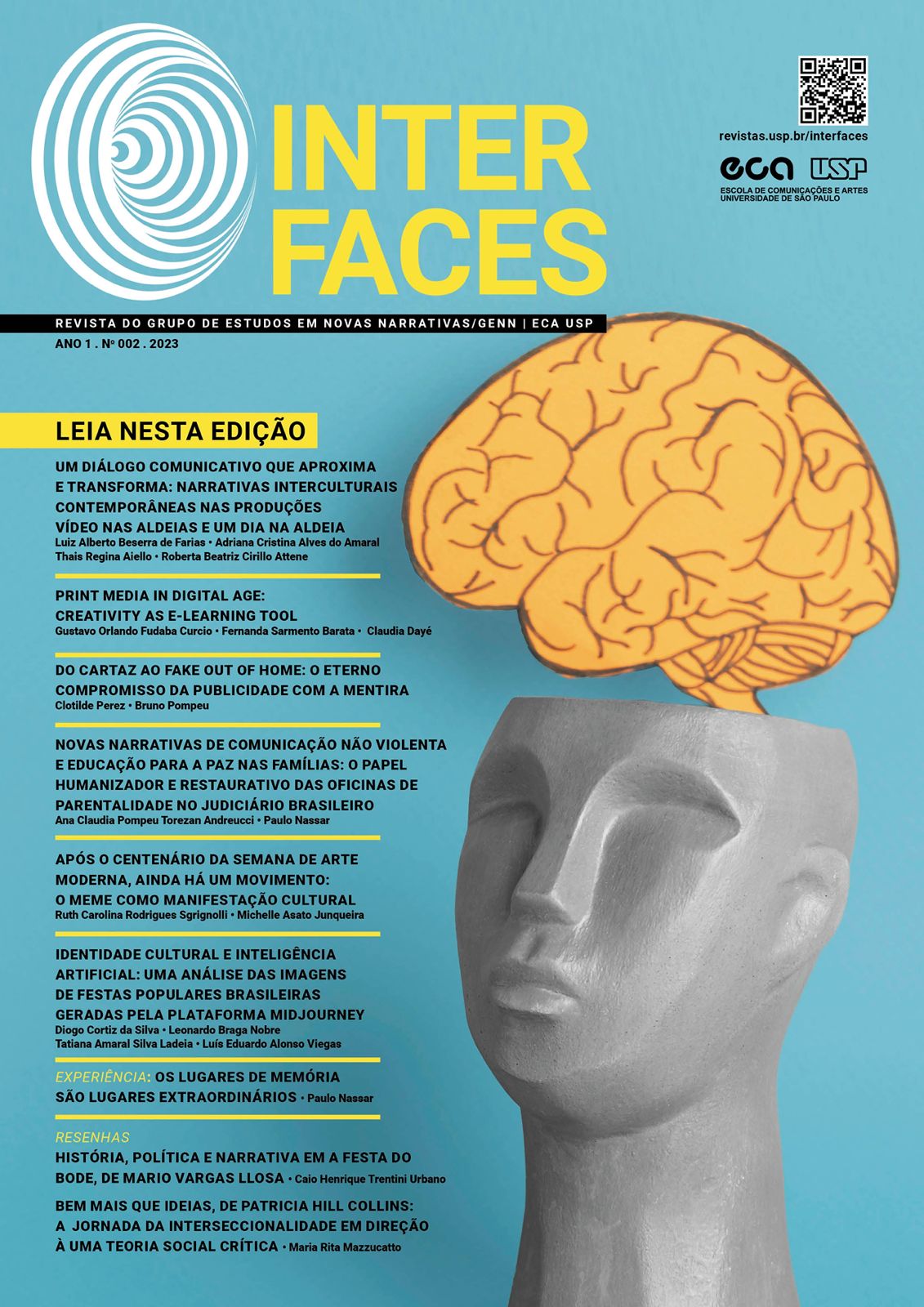Cultural identity and artificial intelligence: an analysis of images of popular Brazilian festivals generated by the Midjourney platform
DOI:
https://doi.org/10.11606/issn.2965-7474.v1i2p85-106Keywords:
Artificial intelligence, Cultural identity, Popular parties, Brazilian culture, MidjourneyAbstract
Artificial intelligence has played a significant changing role in today's society. The objective of this work is to analyze whether generative artificial intelligence systems, especially Midjourney, capture and recreate, in an authentic way, cultural representations. The methodology adopted was Peirce's semiotics, the choice was made because semiotics can assist in the mechanisms of constructing meanings. The results obtained show that generative artificial intelligence systems still cannot, when it comes to cultural representation, be faithful to the elements of cultural identity. Therefore, it is concluded that the systems, when generating digital content about the festivities researched, are unable to eliminate bias and end up creating images that do not represent them.
References
BENEDICT, Ruth. O crisântemo e a espada. São Paulo: Perspectiva, 2007.
CAO, Tong et al. Assessing Cross-Cultural Alignment between ChatGPT and Human Societies: an Empirical Study. Computation and Language, 2023. Acesso em 10 Jun. 2023.
COZMAN, Fabio G; KAUFMAN, Dora. Viés no aprendizado de máquina em sistemas de inteligência artificial: a diversidade de origens e os caminhos de mitigação. Revista USP, São Paulo, n. 135, 2022, p. 195-210.
CHOMSKY, Noam. The False Promise of ChatGPT. The New York Times, 2023. Disponível em: https://www.nytimes.com/2023/03/08/opinion/noam-chomsky-chatgpt-ai.html. 2023. Acesso em 10 Jun. 2023.
FERRARA, Emilio. Should ChatGPT be Biased? Challenges and Risks of Bias in Large Language Models. Computers and Society, 2023. Acesso em 10 de junho de 2023.
GOLDIN, Dina; WEGNER, Peter. The Origins of the Turing Thesis Myth. USA, 2004.
HALL, Stuart. A Identidade Cultural na pós-modernidade. 11ª ed. Rio de Janeiro: DP&A, 2006.
KAUFMAN, Dora. Inteligência artificial e os desafios éticos: a restrita aplicabilidade dos princípios gerais para nortear os princípios de IA. Revista Comunicação, Ética e Ressignificação do humano. v. 5. n. 9, 2021.
MAGALHÃES, João C; COULDRY, Nick. Giving by Taking Away: Big Tech, Data Colonialism, and the Reconfiguration of Social Good. International Journal of Communication, v. 15, p. 20, 2021. Available at:<https://ijoc.org/index.php/ijoc/article/view/15995>. Acesso em 10 Jun. 2023.
MORIN, Edgar. A via para o futuro da humanidade. Rio de Janeiro: Bertrand Brasil, 2013.
NEIVA, Eduardo. Imagem, história e semiótica. Anais do Museu Paulista (nova série). n. 1, 1993.
NIEMEYER, Lucy. Elementos da semiótica aplicados ao design. Rio de Janeiro: 2AB, 2003.
MCCULLOCH, Warren S; PITTS, Walter. A Logical calculus of the ideas immanent in nervous activity. Bulletin of Mathematical Biophysics, v. 5, 1943, p. 115-133.
PARNAS, David Lorge. The real risks of artificial intelligence. Communications of the ACM, v. 60, n. 10, p. 27-31, 2017.
PEIRCE. Charles S. Semiótica. Estudos. São Paulo: Perspectiva. 2005.
PRIMO, Alex. Interação mediada por computador: comunicação, cibercultura, organização. 2ª ed. Porto Alegre: Sulina, 2008.
RAHMAN, Wan. Inteligência artificial e aprendizado de máquina. São Paulo: Ed. Senac, 2022.
RUSSEL, Stuart. A inteligência Artificial a nosso favor: Como manter o controle sobre a tecnologia. São Paulo: Companhia das letras, 2021.
SANTAELLA, Lúcia. Matrizes da linguagem e pensamento: sonora, visual, verbal: aplicações na hipermídia. São Paulo: Iluminuras e FAPESP, 2005.
SANTOS, Silvia S. S. Semiótica e Gestalt: metodologias para análise de imagens visuais. Intercom – Sociedade Brasileira de Estudos Interdisciplinares da Comunicação. X Congresso de Ciências da Comunicação na Região Sul. Blumenau, 2009.
SILVEIRA, Sergio A; SOUZA, Joyce; CASSINO, João F. (Org.). Colonialismo de dados: como opera a trincheira algorítmica na guerra neoliberal. São Paulo: Autonomia Literária, 2021.
STANFORD ENCYCLOPEDIA OF PHILOSOPHY. Ethics of Artificial Intelligence and Robotics. First published Apr 30, 2020. Acesso em 6 Jun. 2023.
STURKEN, M.; CARTWRIGHT, L. Practices of looking: an introduction to visual culture. Oxford/New York: Oxford University Press, 2001.
SUNDELL, Anders. The Most Googled Countries. 2022. Disponível em https://www.visualcapitalist.com/cp/the-most-googled-countries-worldwide. Acesso em 6 Jun. 2023.
TAYLOR, Edward B. La Civilization primitive. Paris: Reinwald, 1878.
TURING, Alan M. et al. On computable numbers, with an application to the Entscheidungsproblem. Journal of Math, v. 58, n. 345-363, 1936, p. 5.
UNESCO. Convenção sobre a proteção e promoção da Diversidade das Expressões Culturais. 2005. Disponível em: https://unesdoc.unesco.org/ark:/48223/pf0000149742. Acesso em 8 de Jun. 2023.
ZHOU, Kaitlyn; ETHAYARAJH, Kawin; JURAFSKY, Dan. Richer Countries and Richer Representations. Computation and Language. 2022. Acesso em 10 Jun. 2023.
SILVA, Diogo C; NOBRE, Leonardo B; LADEIA, Tatiana A. S; VIEGAS, Luís E. A. Identidade cultural e inteligência artificial: Uma análise das imagens de festas populares brasileiras geradas pela plataforma Midjourney. Interfaces da Comunicação, [S. l.], v.1, n. 2, 2023, p. 1-21.
Downloads
Published
Issue
Section
License
Copyright (c) 2023 Interface Communication Review

This work is licensed under a Creative Commons Attribution-NonCommercial-ShareAlike 4.0 International License.



